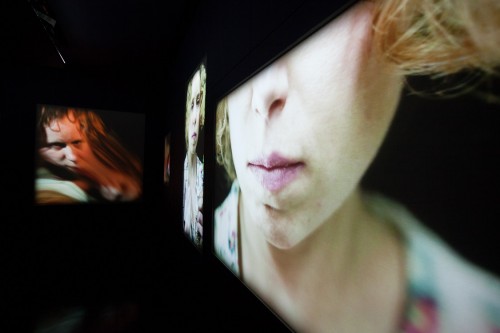
This may sound daft, but I’ve never really thought about what directors do. I mean, I have seen plenty of drama – including Hamlet seven or eight times, plus a couple of film versions – but curiously was always totally incurious about the directorial contribution. I suspect that says more about my intellectual indirection than anything.
Even I couldn’t miss the impact of the director in Five Truths, a video installation I saw the other night at The Howard Assembly Room. It’s all about the direction. Director Katie Mitchell (I’m supposed to say “acclaimed” director, but I object on the grounds that it’s a lazy, vacuous, ingratiating phrase that should be pointed at and mocked whenever it appears in print) presents five films interpreting a famous scene in Hamlet – Ophelia goes potty, chucks herself in the pond, and comes to a sticky end in a perfect pre-Raphaelite photo opportunity. Each film interprets the scene in the style of a famous director; Brecht, Artaud, Brook, Grotowski, Stanislavski. Fame being a relative concept – some directors are clearly more famous than others.
The films were shown on nine or ten screens (I knew I should have counted) of different shapes and sizes, arranged over three walls of a darkened room. I felt surrounded physically (this may be what The Guardian meant by “immersive”) and the films ran at the same time so my head span and my brain couldn’t keep up with the parallel processing (which may be what The Guardian meant when they called the installation “visceral,” though I have to report that my viscera survived the experience intact and unmolested.) Most of the directors had two films, or rather the same action shot from two different angles – only Artaud was singled out for a single vision I think – so each screen came across as just one possible slant on the scene. The films were short, just ten minutes or so, and on a loop. I spent almost an hour watching and could easily have stayed longer.
Individually the films were an absolute joy to watch (sorry, I’ve seen so many video installations that positively reek of student bed sits. This wasn’t one.) Collectively the cumulative effect was stunning. I was genuinely amazed that the same few props and couple of hundred words could be imagined so differently. Ophelia was incredible, appearing on one screen a wailing, jabbering wreck and on another calm and almost casual, with everything from animated lunacy to catatonia in between. Disconcerting to watch but incredibly compelling.
I mentioned on Twitter that I’d have to go back and see the work again as I didn’t feel that I’d fully grasped what was going on. Someone, who should know better, flippantly remarked, “not exactly accessible then!” No, no it’s not, but I don’t think that’s the point. Obviously this is a kind of art at three removes – an installation of videos about modern theatrical interpretations of classic drama – and to appreciate it properly I suppose you would need not only to understand the original Shakespeare but also to have a pretty extensive knowledge of the history of Twentieth Century theatre. That’s totally beyond my limited education. I wouldn’t know my Brook from my Brecht, or Grotowski from a hole in the road. I’m sure I’d see more in the films, appreciate the subtleties and nuances more keenly, if I had such extensive knowledge, but the fact is the films stood up for themselves without the need for footnotes. The films are beautiful, and they also make you think.
They made me think about what a director actually does.
Right now I’m Googling “Grotowski.”
Five Truths is on until 25 Feb, Mon – Sat, 2 – 8pm. And it’s free.